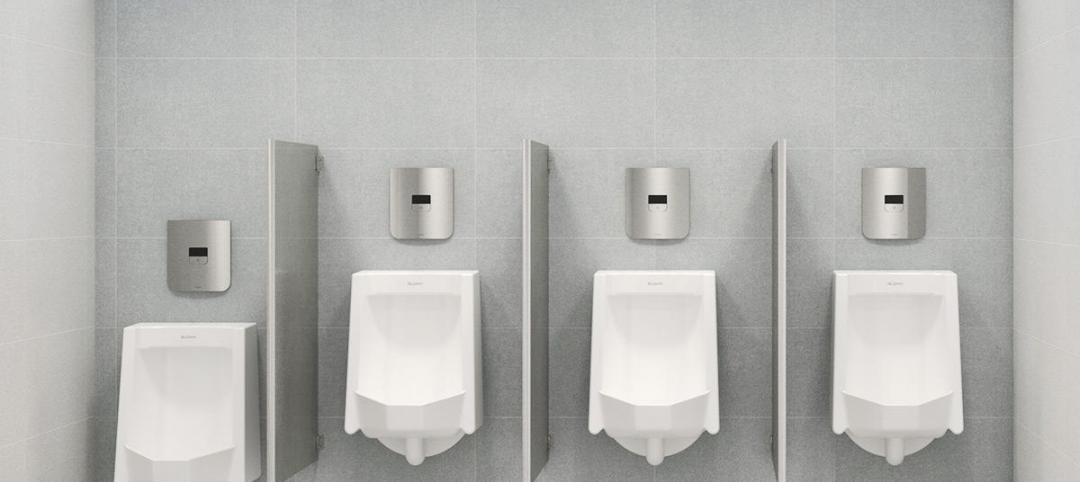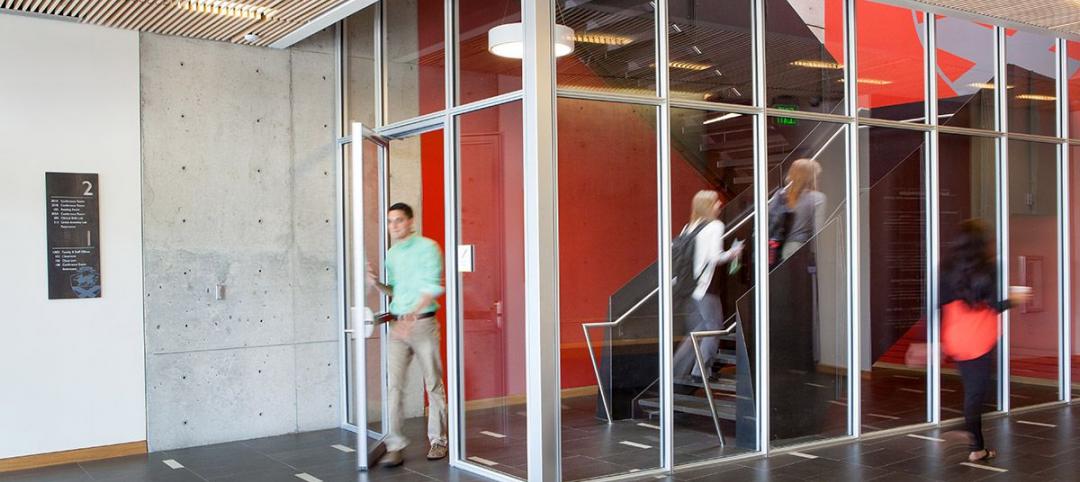Located near Louisville, Ky., Fort Knox is home to the U.S. Army’s Armor Center, Armor School, Recruiting Command, and numerous other facilities. The post has a daytime population of more than 30,000 people and more than 3,000 family housing units. In total, Fort Knox encompasses 11 million square feet of conditioned space across more than 109,000 acres.
A military post of this size consumes a significant amount of energy. Fort Knox is acutely aware of the need for sustainability to ensure continuous operations and meet Federal energy goals and requirements. The post’s Disney Barracks complex demonstrates sustainability in action by using ground coupled heat pumps to move thermal energy from the earth or buildings to provide space heating and cooling.
Facility overview
The Fort Knox Disney Barracks complex is named for Major General Paul Disney, a World War II veteran and first commander of the Armor Training Center at Fort Knox. The complex consists of 38 facilities, including 14 barracks, six dining facilities, six classrooms, battalion headquarters, a chapel, movie theater, and several other facilities. These buildings make up approximately 811,400 total square feet of conditioned space.
At the time of construction in the 1960s, energy efficiency was not a priority. The entire Disney complex was heated from a centralized, high-pressure, high-temperature hot water system. The design, age, and operation of the central heating plant rendered it inefficient and outdated compared to today’s standards. Cooling was equally inefficient. The Disney buildings were cooled from a mixture of decentralized cooling equipment of different ages, efficiencies, and functional conditions.
None of the buildings used automated temperature control systems. In addition, the underground hot water distribution system had many thermal leaks due to age. Only four of the barrack facilities had ventilation equipment, none of which functioned. As a result, windows were always left open for ventilation, which caused discomfort, poor indoor air quality, and mold issues from uncontrolled temperature and humidity.
Equipment failures added to the Disney Barracks complex central heating pitfalls, the most recent of which was a failure associated with the underground piping. Fort Knox received $2 million to repair and replace a portion of the underground hot water distribution system, but opted to use that funding to fix the bigger problem instead of fixing one failing component after another in an outdated, inefficient system.
Fort Knox’s energy consumption analysis of all Disney Barracks complex facilities revealed that the inefficient heating and cooling systems consumed 39% more energy than required. The post decided to replace these systems and converted the Disney Barracks complex in less than six months with geothermal heating and cooling. Use of a utility energy service contract (UESC) dramatically shortened the construction cycle of the energy project and allowed for an operational facility in a fraction of the time the traditional procurement methods required.
Project at a Glance
Federal facility: U.S. Army Fort Knox Disney Barracks
Conditioned square feet: 811,435 square feet across 38 facilities
System overview: Geothermal heat pumps with automated ventilation and control systems
Warranty: 50 years for ground piping system; 25 years for inside components
Annual energy savings: 106,600 MMBtu
Utility partner: Nolin Rural Electric Cooperative Corp.
Year of completion: 2005
Total cost: $10.4 million
Annual energy cost savings: $906,100
Payback: 11 years
System overview
Fort Knox replaced approximately 70% of the existing Disney Barracks heating, ventilation, and air conditioning (HVAC) systems with geothermal heat pumps (GHPs), taking advantage of renewable energy resources. The vertical closed loop GHPs consist of 180 boreholes drilled 500 feet deep, each of which is interconnected. The post also added automated ventilation controls with dedicated fresh air systems and a wireless control system. These systems improve barrack air quality.
Geothermal Technology Overview
Geothermal heat pumps (GHP) move heat from one place to another to provide space heating and cooling throughout the year. In the summer, a GHP transfers heat from inside the facility to the ground outside or below. In the winter, a GHP extracts heat from the ground and transfers it inside the conditioned space.
A GHP system has three major components: the ground loop (buried piping system), the heat pump itself, and the heating and cooling distribution system. Two main types of GHPs exist. Closed-loop systems use sealed horizontal or vertical pipes as heat exchangers through which the heat conductive fluid transfers heat to or from the ground. Open-loop systems pump water to the heat exchanger and then back to the source.
More than 60% of total Fort Knox facility square footage, or more than six million square feet, is served by automated geothermal heating and cooling. Additional ground coupled heat pumps are installed in privatized housing. A central, automated control system pulls all facilities into one, easy-to-use system that serves as the backbone of a post-wide energy management program. More than 140 post facilities are tied into the system with plans to add more in the near future.
Results summary
The renewable energy ground coupled heat pumps at Disney Barracks reduced Fort Knox’s annual energy consumption by approximately 106,600 million British thermal units (MMBtu) in 2006. This is a 10% reduction in natural gas consumption. Electricity use overall changed little from this project.
The Disney Barracks’ GHP system helped Fort Knox and the U.S. Army save more than 102,000 thousand cubic feet (Mcf) of natural gas for a cost savings of $906,100 in 2005. The benefits, however, extend further. The indoor air quality of the Disney Barracks facilities greatly improved, directly benefiting occupant health and working conditions.
Project summary
Fort Knox strives each year to exceed reduction goals set by Federal regulations and requirements. Fort Knox reached this goal and maintained its reputation as a model Army post by effectively utilizing renewable energy and a variety of energy efficiency and management tools. Fort Knox improved quality of life for everyone on the post while reducing energy consumption and expenses. +
--
Resources: Federal Energy Management Program; Department of Energy (DOE) Geothermal Energy Technologies Program.
For more information contact:
Anne Sprunt Crawley Federal Energy Management Program 202-586-1505 anne.crawley@ee.doe.gov
Andy Walker National Renewable Energy Laboratory 303-384-7531 andy.walker@nrel.gov
Related Stories
75 Top Building Products | Dec 16, 2019
Top Window and Door Products for 2019
Pella’s Rolscreen retractable screen and NanaWall’s HSW single-track sliding glass wall are among the 16 window and door products to make Building Design+Construction’s 2019 101 Top Products report.
75 Top Building Products | Dec 16, 2019
Top Structural Products for 2019
Inpro’s Fireline 140 fire barrier and Owens Corning’s Foamglas cellular glass insulation are among the 10 structural products to make Building Design+Construction's 2019 101 Top Products report.
75 Top Building Products | Dec 16, 2019
101 Top Products for 2019
Building Design+Construction readers and editors select their top building products for the past 12 months in the fourth-annual 101 Top Products report.
75 Top Building Products | Dec 16, 2019
Top Plumbing Products for 2019
Sloan's CX Flushometer and Zip Water's HydroTap are among the eight plumbing products to make Building Design+Construction's 2019 101 Top Products report.
75 Top Building Products | Dec 16, 2019
Top Interior Building Products for 2019
Arktura's Delta Drop ceiling and CertainTeed's Decoustics Rondolo wood panels are among the 13 new interior products to make Building Design+Construction's 2019 101 Top Products report.
75 Top Building Products | Dec 16, 2019
Top Glass and Glazing Products for 2019
SageGlass's Harmony dynamic glass and Vitro Architectural Glass's Acuity low-iron glass are among the nine new glass and glazing products to make Building Design+Construction's 2019 101 Top Products report.
75 Top Building Products | Dec 16, 2019
Top Flooring Products for 2019
Tarkett’s aviation-inspired flooring collection and J+J Flooring’s textile composite flooring are among the four new commercial flooring products to make Building Design+Construction’s 2019 101 Top Products report.
75 Top Building Products | Dec 16, 2019
Top Building Systems Products for 2019
FabricAir’s ceiling-hung fabric duct and Ellumi Lighting’s bacteria-killing lights are among the 13 new building systems products to make Building Design+Construction's 2019 101 Top Products report.
75 Top Building Products | Dec 12, 2019
Top Building Envelope Products for 2019
Sto's beetle-inspired exterior coating and Dörken Systems' UV-resistant vapor-permeable barrier are among the 28 new building envelope products to make Building Design+Construction's 2019 101 Top Products report.
Architects | Dec 10, 2019
Calling all emerging architects: Enter to win the $20,000 Forge Prize
This annual steel design competition will recognize three Finalists ($10,000 each) and one Grand Prize Winner ($20,000 total) for their novel concepts in steel-based structures. Entries are due Jan. 15, 2020.

















